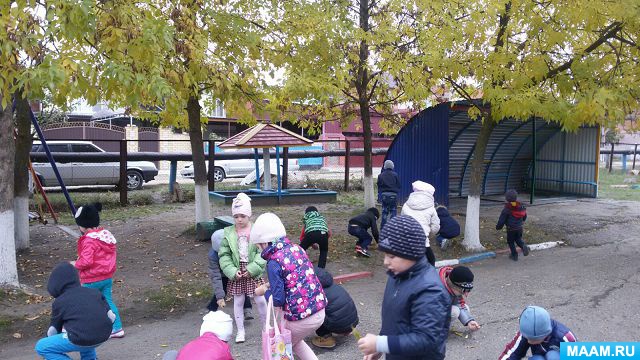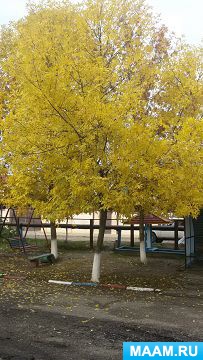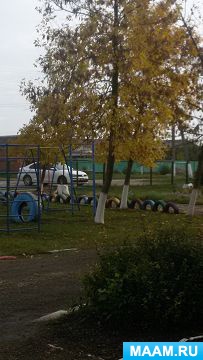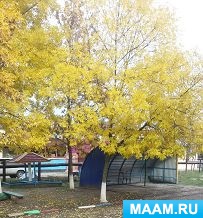Marina Zhuravko
Target: to give children the idea that when it comes autumn, the height of the sun changes, it stops warm up the air, the days are getting shorter and the nights are longer, people are dressing warmer.
Tasks:
Contribute to the expansion of children's knowledge of the characteristic features autumn emphasizing the beauty autumn nature and variety of colors;
Building a fake stick Take 4 sheets of black felt. Glue them onto a large piece of cardboard that you hang on the wall. Then, using the children, draw and cut out different felt shapes in different colors. You will see that the figures are sticks and just fit on the felt. Children will have fun and destroy autumn scenery. Change shapes as seasons and themes change.
Follow new Pony Rhymes due to themed events every week. A small leaf that spins in the wind. A small leaf that turns and flies. A small leaf that turns as it falls. A small leaf that lies on the ground.
Create conditions to encourage children to speech activity;
Contribute to the development of observation, education of curiosity and love for native nature;
Create conditions for research activities;
To form an idea of the importance of work, to teach to carry out the work begun to the end;
Create conditions for the organization of motor activity.
It's autumn, autumn. Leaves are falling, leaves are falling. Everywhere on earth, everywhere on earth It's so beautiful, it's so beautiful. Leaf in the wind, flies, thieves, flies, flies. Leaf in the wind, flies, flies, flies swirl. She rides merrily, steals, steals, steals, flies. She walks briskly, and the others do the same. But sometimes the teasing wind steals, steals, steals, steals. But sometimes the teasing wind pushes him too hard.
Small leaves in spring. Large leaves in summer. Autumn full of leaves. A real challenge for modern parents lies in the hustle and bustle Everyday life to find time and have fun with your kids. Studies have shown that spending more time with family has a positive effect on children. younger age- Increases self-confidence and self-confidence strengths and opportunities, strengthens family ties, develops qualities that contribute to social communication in conditions outside the world.
The age characteristics of five-six-year-old children are characterized by increased attention to everything that happens during outside world. One has only to observe the behavior of the children, how it becomes it's clear: They are interested in monitoring changing environmental conditions. Based on this statement, it is possible and necessary to organize classes with children directly on walk so as not to waste precious time. walk in the middle group in autumn Autumn Walk with kids middle group can bring undeniable benefits, make a significant contribution to their becoming: the development of cognitive processes (memory, thinking, imagination, speech, creative skills, the formation of interest in native nature and what happens to it. With regular classes of this type, children gradually develop a bright, clear idea of \u200b\u200beach season, its distinctive features. Soon children will be able to easily answer questions about how winter differs from autumn, but autumn from summer.
How to create unforgettable memories of your children from the time spent together at home or in nature? Taking the kids out on a picnic out of town or even to a nearby park on a Sunday is a wonderful outing for the whole family, but imagine what a real adventure it would make if you also organized a Warm, Hot, Cold subject search. Each of you can give your imagination the freedom to figure out what and where to hide, what rules of the game to determine, and take this into account with the age and interests of your children.
If you have a river, lake, or lake near your city, you can rent a boat for a few hours and enjoy the excitement and happiness it will bring to little sailors. A curious and unforgettable pastime for your children would be to draw ceramic pots by themselves. Find an art studio that offers this opportunity. This activity develops in a special way creative creativity your children and leaves a beautiful material memory for a long time.





Related publications:
If, for financial or other reasons, you cannot afford a longer trip, visit the tourist information center in your city and prepare a surprise for your children. choose historical monuments, museums and cultural attractions depending on their age and interests. Prepare yourself in advance with intriguing stories and legends about the places you visit together. Knowing the interesting and valuable sites in your city will promote your children's self-esteem and awareness.
And if a gloomy and rainy Sunday has made the family stay at home, announce the hours from 16 to 20 for "appliances excluded time" and entertain the children with your favorite toys. Make sure they are happy even if you just sit on the floor next to them and watch them build a tower of blocks or swap dolls.
I present to your attention a presentation on the topic: "Integration educational areas when taking a walk. The importance of the game in time.
What could be more pleasant than a walk with children? Walking is one of the main recreational activities in kindergarten warning.
Integrating educational areas when conducting a walk. Importance of playing while walking Volodina Elena Integration of educational areas during the walk. Significance of the game during a walk I present to your attention.
Or why it's important to have most of these accessories
It's warm and sunny, but unfortunately, after that, autumn always comes, sometimes sweet and smiling, golden and warm, but often rainy, windy and gloomy. This is certainly no reason to return home with our little treasures. Enough time to take care of the right clothes, accessories and accessories to meet her and turn the outing into an anticipated and positive emotional adventure.
Getting all the necessary things for a relaxed and warm walk with a few whims in the park in autumn can take us a long time, but the idea of buying quickly and efficiently from the Internet is what. It's fast, delivery will reach the door, and the order can be completed while the baby is sleeping at your fingertips.
Consultation "Methods of organizing a walk in kindergarten" Slide number 1: Children's stay in the fresh air has great importance for physical development preschooler. The walk is the first and most.
August has arrived! the weather pleases it's hot outside. So we decided to sunbathe. After all, the sun's rays are so pleasantly warm. And the water is the best.
Be friendly to the child in the rain, in the fog. For rainy autumn days, it is important to have raincoats for babies and their strollers, as well as for older children who will not lie while admiring the swollen puddles. It also requires strong rubber boots as well as waterproof jackets. Against wetting, the ideal job will be done by waterproof baby overalls and if the baby is small and we love to carry it right to your heart - the kangaroo has the solution for this with a special kangaroo raincoat.
Natural fabrics for natural comfort. Warm, soft and light clothing is one of the basic conditions for a good mood for a child and a small child, because when he is outside he likes to move, which is a prerequisite for light sweating and therefore for a cold. That's why clothing from underwear to top is important to have natural and breathable fabrics that allow moisture in and retain warmth so that delicate baby's skin is protected and dried at all times.
Every home starts with a yard. The first acquaintance of guests and just passers-by begins with appearance home, landscaping. Not by chance.
Organization and conduct of walks in kindergarten ORGANIZATION AND MANAGEMENT OF A WALK IN KINDERGARTEN 1. A walk is very important regime moment life of children in preschool. Target.
For every child's skin Often, when a child is dressed with too many clothes, it happens that the skin in the seams is cut off. Anti-crunchy cream is an important part of preparing before a walk. Therefore, before putting on diapers, it is best to slather sensitive areas with a suitable baby cream to keep baby's skin healthy.
Feeding your baby outside In the fall, although the days are more common and cloudy, it's good to spend as much time outside as possible. Often, however, we rush home because the child needs to eat, more often than long walks are offered. In order not to be in a hurry, and especially if we have the inconvenience of breastfeeding in a public place, we can get a bottle of milk to extend our stay and successfully breastfeed the baby. For larger children, thermos tea would be an ideal job.
Canopy walk on the theme "At the flower bed"
Target: introduce children to the names of several flowers - phlox, marigold (calendula). Show older children the structure of the plant; to consolidate the concepts of high, low (flower), long, short (stem).
Progress of the walk
Children slowly walk around the flower beds, admire the autumn flowers, speak freely. The teacher first finds out which flowers are already familiar to the children, and then introduces them to new ones. “We have a beautiful flower bed, big. We walk around it, admiring the flowers. And who will show me a red flower? And white? Children are happy to show red, white, orange and purple flowers.
Of course, this is also the season in which we always have a bib and a scarf. This is where the pioneering invention for the pectoral fin comes in, which adjusts around the baby's neck depending on which target we'll be using. Keep a hat so that the child does not get sick. That's why we probably buy this accessory more than anyone else. Well, if we expect a child's desire to fight with head hats, there is an offer just for such cases - with tightly sewn ties to keep it on the child's head for as long as possible.
Goodbye, dear, but at another time. As hard as we can resist pacifiers and try to get rid of them, there is an age when we have no choice whether to take them, and if we don't want our walk to end without time, with a hysterical roar, it's good to take it with us. . It doesn't have to be on the baby's neck or in the mouth, we can take it without the risk of staining in a special container where it will stay clean for a long time.
The teacher praises each child, asks what the flower is called, gives the exact name, and then continues: “Look, children,
some flowers are high, you can’t reach the top of the head (leads them to rudbeckia (golden balls)), while others are low (everyone bends over, sits down at pansies, mignonettes). Now go around the flower bed and show low flowers (nasturtium, marigolds). Show high (phloxes, dahlias)." Each time a flower is shown, everyone together correctly names it. The teacher suggests approaching the phlox: “See what a tall flower? Phlox has a long stem. Swipe. What color are phloxes? And what else? (Children walk around the flower bed, looking for phloxes.) Now show them the leaves.
Sleep outside - in a sack For the youngest outings, it's good to have a baby sack in which they feel cozy and, of course, warm, even when the mercury in the thermometer goes down the autumn scale. It is very practical both outdoors and on cool nights at home.
Beat on the pavement, but not in the fall. For children who are walking or have already passed, comfortable shoes are of great importance. Children's shoes should be made of natural fabrics, have a strong and stable foot that is not skates, a wide top so that the toes are free, and the heel is secure and durable with a strong back.
On the example of phlox, children get acquainted with the structure of a flower, smell it. "Beautiful flowers!" - says the educator.
The children go out to play. The teacher invites the remaining children to make patterns of autumn leaves on the path, alternating red and yellow leaves. If the children's interest has not dried up, you can invite them to lay out colorful carpets of leaves, supporting the children's imagination.
Yes, give me mommy, blue wig. For bigger kids who run and jump all the time when they're in the park, it's a good idea to have a lighter coat or bun on hand that doesn't hinder movement but still keeps the baby's body heat securely in.
For adult baboons with self-confidence. Especially for little girls, every detail of the toilet is important for them. We can't take them for a walk or go to kindergarten on a rainy morning unless they have a small backpack to pack their precious treasures and a small umbrella for sunshine and rain.
At the end of the walk, you can play the game "Wave, wreath!".
Leaving the walk, the teacher carefully cuts a few flowers, makes a bouquet. At the same time, he repeats every time: “This is an aster! Another aster, these are phloxes, dahlias. Children watch his actions, memorize the names of colors; then everyone decides together who the bouquet is intended for.
Wet wipes we can't live without. Of course, in a park without wet wipes, we simply get lost! Therefore, at least one medium-sized bag should always be on hand. Magic bag, it suits everyone. And if you ask where to get all this, there will be only one answer - without a universal bag that you have to put on your shoulder or hang on a cart, it's better not to go. And countless pockets, nothing beats a baby bag!
And finally, to keep your hands safe from wind and rain, don't forget to take good care of them. Gentle hand cream is clear, but even so, your hands will be exposed to all weather conditions unless you have universal trolleys. Well, you're human, after all, at least you deserve it!
Canopy walk for children 3-4 years old on the theme "Big watering can"
Target: observe with children the work of a janitor; introduce the name "watering machine".
Progress of the walk
Warm sunny autumn day. The trees are decorated with variegated leaves, especially bright leaves at the maple The teacher draws the attention of children to the beauty of the autumn day. "Hello, golden sun, hello, blue sky!" the children repeat after the teacher.
And not only within 15 days, you can replace or return the product you purchased if for some reason it does not meet your expectations. Well, that's not all, but it's part of the idea to keep being active in the fall, if not as much as in the summer, at least half, because physical activity, outdoor walks and park games are health for our children and the right choice for each of us.
Autumn is beautiful with all these colors. Every walk in the park is a great opportunity to play. We will give you a lot of ideas, but don't forget to plow on the autumn leaves and look into the puddles, of course, well armed with wellington boots and another pair for transformation.
The teacher draws their attention to the work of the janitor, who sweeps autumn leaves; invites them to take brooms and help the janitor: "The janitor works with a big broom, and the children with brooms." Children help the janitor finish the job.
The janitor praises the helpers and starts watering the flowers in the flower bed. The children are nearby. Everyone slowly moves around the flower bed, watches how water slowly flows from the watering can, names the flowers that wash, drink water, raise their heads to the sun, smile at everyone.
Outside there are the most interesting things to explore. Put the hand of the youngest to brush the bark of the tree and ask them if it feels rough or smooth. Break the sheet up to the child's ears. Collect a couple of leaves from different trees. Mix them up and have your child match them in pairs.
If the bear is the child's favorite toy, then help organize his winter quarters during a walk in the park. Use the materials that nature offers. What does the child think about putting into the void? What do you need for Mechoka's winter dream?
Knowing at what time a watering machine passes along the street, the teacher takes the children to the sidewalk. They are talking animatedly, seeing from a distance a slowly moving car in sparkling spray. The teacher asks everyone to move away from the road, but all the same, the children are happy to feel moisture on their feet when a light breeze brings splashes of water to them.
Moving at a distance behind the car, they note: the car waters the street, washes, so that it is clean, beautiful. But then the car stopped at the lawn, watering it. Children immediately comment: “I got drunk, washed the flowers!”, “This car is a big watering can!”
Returning to the site, the children play the outdoor game "On a narrow path."
Canopy walk for children 3-4 years old on the topic “Where does what grow?”
Target: give children the concept of fruits and berries; recall the structure of plants (tree, bush).
Progress of the walk
The teacher invites the children to go to the garden and see what the older children are doing there. Toddlers watch with interest as older children take buckets of apples, pears, plums to the pantry. The teacher asks if these fruits are familiar to children, and then clarifies that fruits grow on trees: “What do you know about trees?” “A tree has a trunk, branches, leaves,” the children answer. The teacher clarifies: “You can get apples, pears only by substituting a ladder, otherwise you won’t get it, it’s high. Fruits ripened all summer, poured sweet juice in the sun, and now autumn has come, they are ripe.”
Everyone examines the fruits, at the suggestion of an adult they inhale the aroma of apples, and then join in the common work: they take the fruits in buckets to the kitchen. The cook thanks everyone and promises to prepare delicious compote for lunch.
Bushes of red and black currants grow not far from the fruit trees. The teacher, together with the children, clarifies that the bushes are lower than the tree, they do not have a trunk, only branches and leaves. The branches of the bush are thinner than the branches of the tree, the leaves are smaller. Children are interested in looking at the berries of black and red currants on the bushes, specifying their color.
The teacher substitutes a basket, offers carefully, without damaging the plants, to pick berries. Children diligently collect currants. The teacher explains why you can’t try berries yet. The children agree.
Returning to the site, the children sit around the table, the teacher brings a pre-prepared dish with washed fruits and berries, and the game begins. The younger ones guess them by taste, and the older ones by smell, and then by taste; everyone remembers what grows on a tree, what on a bush. The teacher says that compote and jam can be made from all these fruits. Children talk about their observations of cooking these dishes at home. The teacher helps them with questions, clarifications.
Then everyone goes to play. At the end of the walk, the game "Run to what I call" is played.
Canopy walk for children 2-4 years old on the topic “We will help!”
Target: consolidate children's knowledge about vegetables, their shape, size, color.
Progress of the walk
The teacher invites the children to go to the garden beds and observe what the older children are doing there. The harvest is underway. The teacher tells how the older children worked together with adults all summer, watered the beds, and now, when autumn has come, the vegetables have ripened. "Let's help you!" kids offer. The elders don't mind.
The children brought a large vegetable basket. Work begins. The teacher clarifies: “These are red tomatoes. Where do they grow: on a tree or on a bush? What color, what shape are tomatoes - children are happy to answer these questions themselves. When comparing two tomatoes, they can accurately answer the teacher which one is smaller or larger, lighter or heavier.
Then everyone looks with interest among the foliage for cucumbers. Children discuss why cucumbers are hard to find. “Probably, they are indulging, so they are hiding!” they decide together. Older children compare two cucumbers: which is longer or shorter, heavier or lighter. What you find is all in the trash.
Everyone admires the cabbage, which has sat down in the middle of the garden, is resting, basking in the sun and does not want to leave. “We won’t pull it out ourselves!” - the children decide, leaving attempts to cope with stubbornness. The teacher offers: “Tell me, what kind of cabbage?” Children answer: “White and green, round, heavy and stubborn, does not obey!” The teacher helps to pull out the cabbage. It is added to the rest of the vegetables.
The teacher continues: “And there are also vegetables that are buried in the ground and sit there in the dark. We hid! Let's find them!" Offers to pull the fun curly ponytail. Children carefully pull, but do not know what they are pulling out. Turned out it was a carrot! Yes, it's big and orange. Well, just a beauty! And why is such a beauty buried in the ground! One carrot is big and the other is small. "It's a daughter!" children explain.
On the next bed, too, only the leaves are visible. Maybe someone is hiding here? The children pulled, pulled out a round, burgundy beetroot. They began to think about what kind of “tail” to pull in order to pull out larger beets. We decided, chose, pulled, but it turned out that the second beet was smaller and lighter. Children themselves determined this, comparing with the first. The kids thank the older children for being allowed to work in the beds.
The children return to the site, sit around the table, and the teacher lays vegetables on a tray and reads Y. Tuvim's poem "Vegetables". Then he asks everyone: “Which of these vegetables can be eaten raw, but washed?” Children try a little bit of cucumbers, tomatoes, carrots, cabbage. They clarify that the hare would be delighted: there is his favorite treat on the tray. Once again, they recall and clarify which vegetables grow on the ground, and which ones are hidden in the ground.
After that, everyone plays the game "Shaggy Dog" together.
